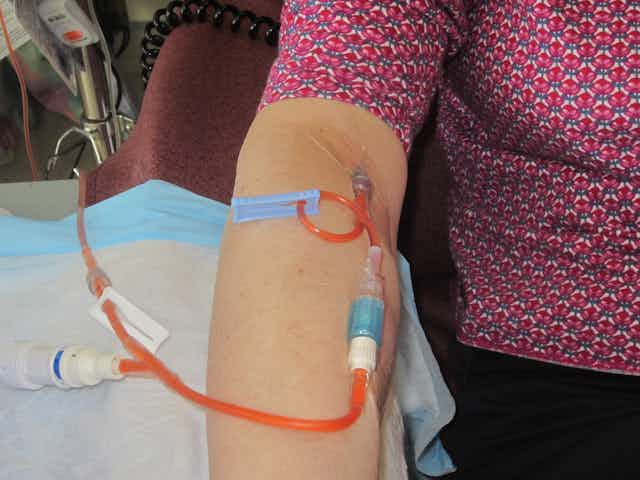Chemotherapy is the use of chemical drugs to treat cancer in humans and animals. It is rarely used by itself and is typically combined with surgery, immunotherapy and radiotherapy.
While chemotherapy is a highly effective treatment for many cancers, it can be improved. Its two major drawbacks are severe side effects and the ability of cancers to develop resistance to further treatment.
Recently, it was revealed that more than 70 patients at Sydney’s St Vincent’s Hospital who underwent chemotherapy for head and neck cancer were given far less than the recommended dose of the drug carboplatin.
While it is unclear, there is a chance this may have affected the success of their treatment.
So how does chemotherapy work and why is the dose so important?
Types of chemotherapy drugs
Chemotherapy can be used either to shrink cancers before radiotherapy or surgery, or to mop up cancer cells left behind after the main treatment.
There are many different classes of chemotherapy drug but most act by causing cancer cells to kill themselves in a process called apoptosis.
The major drug classes include the nitrogen mustards, taxanes, antimetabolites, anthracyclines, vinca alkaloids, antibody drugs and platins. No one drug is used for any one cancer and most are used in combination for a range of cancers.
One of the most important families of chemotherapy drugs, and the one at the heart of the St Vincent’s scandal, are platins. These work by binding and bending DNA inside cancer cells which stops the DNA from being able to replicate. This causes the cancer cell to recognise something is wrong and go into apoptosis.
The major drugs in this class are cisplatin, carboplatin and oxaliplatin. In Australia, carboplatin is used in the treatment of ovarian, lung, and head and neck cancers.

Problems with chemotherapy
Chemotherapy drugs are very good at killing cancer cells but they also cause severe side effects.
These arise because the drugs aren’t selective for cancer cells and kill any part of the body that grows very quickly. This includes bone marrow (which makes blood cells), the lining of the mouth, stomach and intestines, as well as hair follicles.
Cancers can also develop resistance to chemotherapy which actually stems from the issue of side effects. The side effects limit the amount of drug that can be given to patients, and as a result, many are treated with levels of drug that are sub-lethal to the cancer.
Part of the cancer may die from the treatment but the part left over grows stronger after each dose until the drug becomes ineffective.
The St Vincent’s scandal
In February 2016, the ABC reported that more than 70 patients were given a flat 100 mg dose of carboplatin to treat their head and neck cancers.*
This is incredibly low. Unlike most other drugs, the dose a chemotherapy patient is given isn’t fixed. Instead it’s individually selected based on height, weight and their underlying health.
The specific carboplatin dose for a patient is determined in one of two ways. The first is based on how much is circulating in their system (called Area Under the Curve or AUC). Alternatively, it is based on their body surface area (BSA).
When BSA is used, a treatment dose of carboplatin is between 300 and 450 mg per square metre. A person who is 178 cm tall and who weighs 81 kg has a BSA of two square metres and would receive a dose between 600 to 900 mg, once every three to four weeks.*
Doses of chemotherapy would be lower if used in combination with radiotherapy but would still need to be individualised.*
A flat dose of 100 mg weekly could mean patients were massively under treated which would mean a lower chance that their treatment would work. They could run the risk of their cancer developing resistance to further treatment and having it spread throughout their body.*
It would be expected that some people in a group this size would die from their cancers regardless of treatment. Given this, it is difficult to know whether those patients whose tumours spread and who subsequently died from their cancer did so because of under-dosing.
Chemotherapy is, and will continue to be, an important part of the treatment regimen for many cancer patients. Doctors select specific drugs based on the type of cancer the patient has and their dose is individually selected to maximise effectiveness while minimising side effects.
When this process isn’t followed correctly, the patient is at risk of ineffective treatment and could die.
*The final section of this article has been amended to more accurately reflect frequency of chemotherapy dosing and use of radiotherapy in conjunction with chemotherapy. The calculation exemplifying characteristics of a patient receiving 100 mg doses was based on a three to four weekly, rather than weekly, dose, and has been removed. This article originally said the source of the February 2016 report was St Vincent’s hospital rather than the ABC. This has now been corrected.

